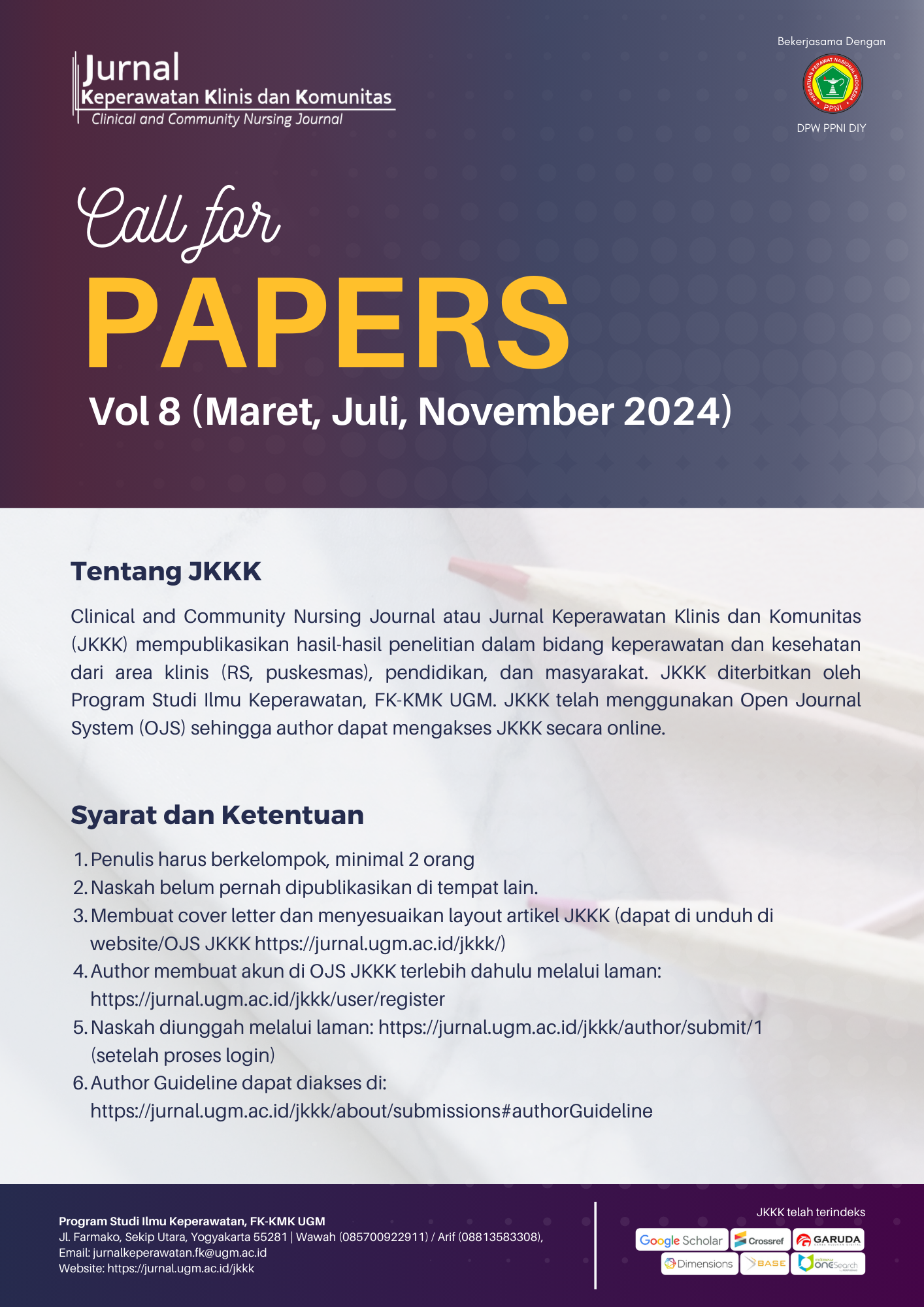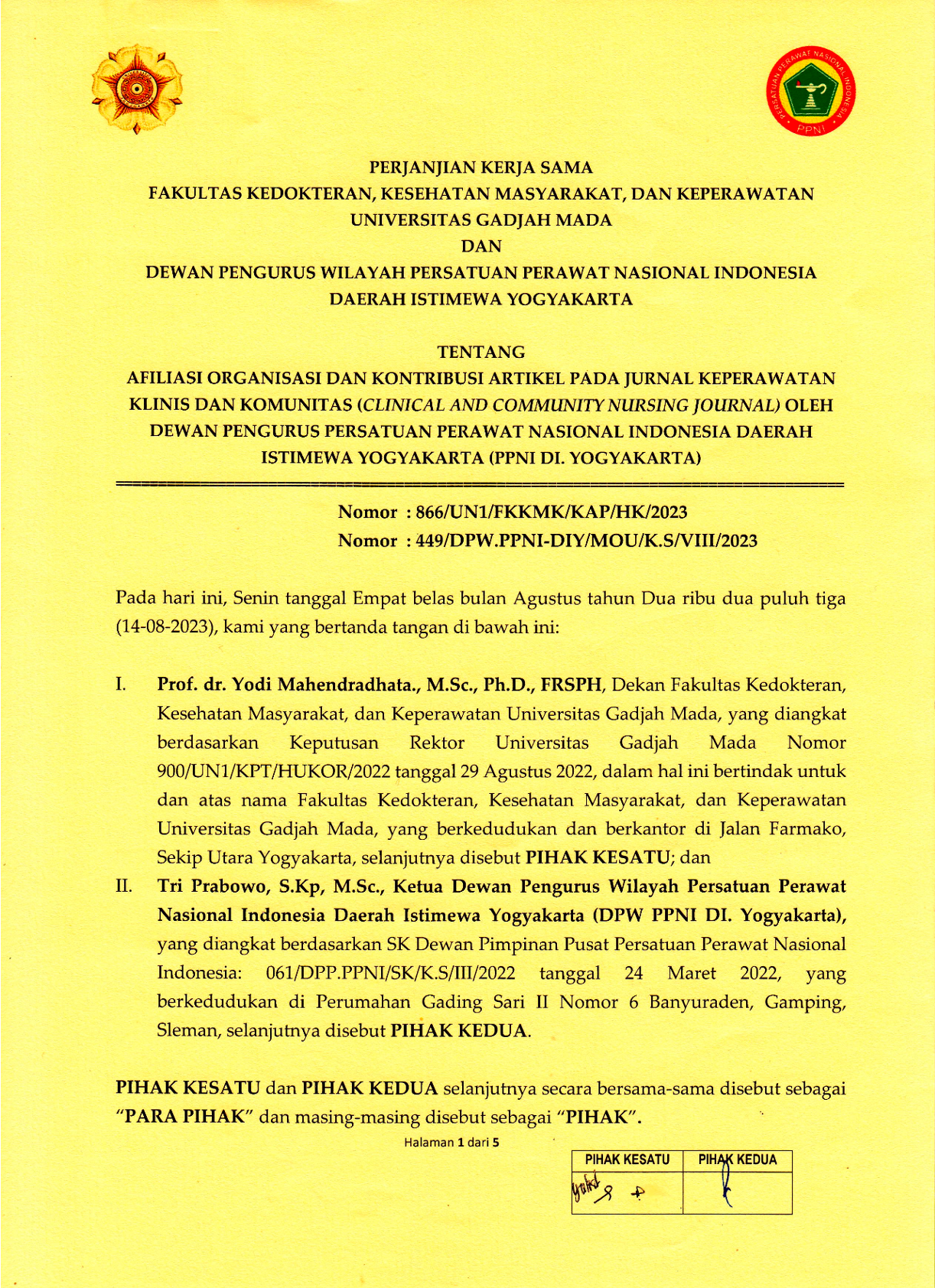Gambaran Kecenderungan Orthorexia Nervosa pada Mahasiswa Program Studi Kedokteran FK-KMK UGM
Mutiara Anisha Zahra(1), Irwan Supriyanto(2), Sri Warsini(3*)
(1) Program Studi Keperawatan, Fakultas Kedokteran, Kesehatan Masyarakat, dan Keperawatan, Universitas Gadjah Mada
(2) Departemen Kedokteran Jiwa, Fakultas Kedokteran, Kesehatan Masyarakat, dan Keperawatan, Universitas Gadjah Mada
(3) Departemen Keperawatan Jiwa dan Komunitas, Fakultas Kedokteran, Kesehatan Masyarakat, dan Keperawatan, Universitas Gadjah Mada
(*) Corresponding Author
Abstract
Background: Orthorexia nervosa (ON) is a new psychological disorder that still needs further research. People living with ON have unsafe obsession with eating healthy food. Research related to ON among graduate students in Indonesia, especially medical students, has not been done.
Research Objectives: This study aims to determine the proportion of orthorexia nervosa (ON) tendency and to investigate certain characteristics that might influence ON tendency among medical students at FK-KMK UGM.
Methodology: This research was a descriptive study with a cross-sectional design. Data collection took place in October-November 2019. Respondents involved were 97 students. The instrument used was ORTO-15. The results were analysed with Chi-Square Test and Fisher Test.
Results: The proportion of ON tendency among respondents was 44.3% (cut-off point 40) and there were significant relationship between ON tendency with the habit of respondents to access health related articles in web pages and social media.
Conclusion: The ON tendency among medical students in FK-KMK UGM is relatively high with a prevalence percentage of 44.3%. Prevention efforts need to be made so that this trend does not develop into an actual health problem.
ABSTRAK
Latar Belakang: Orthorexia nervosa (ON) merupakan gangguan psikologis baru yang masih perlu banyak diteliti dengan ciri-ciri penderita memiliki obsesi berlebih terhadap pola makan yang dianggap sehat. Hingga saat ini penelitian terkait ON pada mahasiswa di Indonesia, khususnya mahasiswa kedokteran belum dilakukan.
Tujuan Penelitian: Penelitian ini bertujuan untuk mengetahui proporsi kecenderungan orthorexia nervosa (ON) dan karakteristik responden yang memengaruhi kecenderungan ON pada mahasiswa Prodi Kedokteran FK-KMK UGM.
Metodologi: Penelitian ini adalah penelitian deskriptif dengan desain cross-sectional. Pengambilan data berlangsung pada bulan Oktober-November tahun 2019. Responden yang terlibat sebanyak 97 mahasiswa. Instrumen yang digunakan adalah ORTO-15. Hasil analisa dilakukan dengan Chi-square dan Fisher test.
Hasil: Proporsi kecenderungan ON pada responden adalah 44,3% (cut-off point 40). Ditemukan hubungan signifikan antara kecenderungan ON dengan kegemaran responden untuk mengakses laman berkaitan dengan kesehatan di sosial media (p<0,05).
Kesimpulan: Kecenderungan ON pada mahasiswa kedokteran FK-KMK UGM tergolong tinggi. Perlu dilakukan upaya pencegahan agar kecenderungan ini tidak berkembang menjadi masalah kesehatan yang aktual.
Keywords
Full Text:
PDFReferences
- Bratman S. Orthorexia vs. Theories of Healthy Eating. Eat Weight Disord. 2017; 22(3): 381–5.
- Bartrina JA, Medicina D De, Pública S, Navarra U De. Ortorexia O La Obsesión por La Dieta Saludable. 2007; 57: 313–5.
- Costa CB, Hardan-Khalil K, Gibbs K. Orthorexia Nervosa: A Review of The Literature. Issues Ment Health Nurs [Internet]. 2017; 38(12): 980–8. Available from: https://doi.org/10.1080/01612840.2017.1371816
- Hyrnik J, Stochel M, Jelonek I, Siwiec A. Prevalence of Orthorexia Nervosa among Polish Adolescents – Assessment Made by The ORTO-15 The effect of Atipical Antipsychotic Medications in Anorexia Nervosa and Dissociative Disorders in Males : A Case Report. Eur Psychiatry. 2016; 33:
- Barnes MA, Caltabiano ML. The Interrelationship between Orthorexia Nervosa, Perfectionism, body Image and Attachment Style. Eat Weight Disord. 2017; 22(1): 177–84.
- Oberle CD, Samaghabadi RO, Hughes EM. Orthorexia Nervosa: Assessment and Correlates with Gender, BMI, and Personality. Appetite [Internet]. 2017; 108: 303–10. Available from: http://dx.doi.org/10.1016/j.appet.2016.10.021
- Barthels F. Orthorexic Eating Behaviour as a Coping Strategy in Patients with Anorexia Nervosa. Eat Weight Disord - Stud Anorexia, Bulim Obes. 2017; 22(2): 269–76.
- Gramaglia C, Brytek-Matera A, Rogoza R, Zeppegno P. Orthorexia and Anorexia Nervosa: Two Distinct Phenomena? A Cross-Cultural Comparison of Orthorexic Behaviours in Clinical and Non-Clinical Samples. BMC Psychiatry. 2017; 17(1): 1–6.
- Brytek-Matera A, Rogoza R, Gramaglia C, Zeppegno P. Predictors of Orthorexic Behaviours in Patients with Eating Disorders: A Preliminary Study. BMC Psychiatry. 2015; 15(1): 1–9.
- Luck-Sikorski C, Jung F, Schlosser K, Riedel-Heller SG. Is Orthorexic Behavior Common in The General Public? A Large Representative Study in Germany. Eat Weight Disord [Internet]. 2019;24(2):267–73. Available from: http://dx.doi.org/10.1007/s40519-018-0502-5
- Missbach B, Hinterbuchinger B, Dreiseitl V, Zellhofer S, Kurz C, König J. When Eating Right, is Measured Wrong! A Validation and Critical Examination of The ORTO-15 Questionnaire in German. PLoS One. 2015; 10(8): 1–15.
- Koven NS, Abry AW. Neuropsychiatric Disease and Treatment Dovepress The Clinical Basis of Orthorexia Nervosa: Emerging Perspectives. 2015; 385–94.
- Barthels F, Meyer F, Pietrowsky R. Orthorexic and Restrained Eating Behaviour in Vegans, Vegetarians, and Individuals on A Diet. Eat Weight Disord [Internet]. 2018; 23(2): 159–66. Available from: http://dx.doi.org/10.1007/s40519-018-0479-0
- Reynolds R. Is The Prevalence of Orthorexia Nervosa in An Australian University Population 6.5%? Eat Weight Disord. 2018; 23(4): 453–8.
- Varga M, Thege BK, Dukay-Szabó S, Túry F, van Furth EF. When Eating Healthy is Not Healthy: Orthorexia Nervosa and Its Measurement with The ORTO-15 in Hungary. BMC Psychiatry. 2014; 14(1): 1–11.
- Dunn TM, Bratman S. On Orthorexia Nervosa: A Review of The Literature and Proposed Diagnostic Criteria. Eat Behav [Internet]. 2016;21:11–7. Available from: http://dx.doi.org/10.1016/j.eatbeh.2015.12.006
- Ramacciotti CE, Perrone P, Coli E, Burgalassi A, Conversano C. Orthorexia Nervosa in The General Population : A Preliminary Screening Using A Self-Administered Questionnaire (ORTO-15). 2011; 16 (June): 127–30.
- Saddichha S, Babu GN, Chandra P. Orthorexia nervosa presenting as prodrome of schizophrenia. Schizophr Res [Internet]. 2012; 134 (1): Available from: http://dx.doi.org/10.1016/j.schres.2011.10.017
- Lopes R, Melo R, Dias B. Orthorexia Nervosa and Comorbid Depression Successfully Treated with Mirtazapine: A Case Report. Eat Weight Disord - Study Anorexia, Bulim Obes. 2018; 0(0):
- Moroze RM, Dunn TM, Craig Holland J, Yager J, Weintraub P. Microthinking About Micronutrients: A Case of Transition From Obsessions About Healthy Eating to Near-Fatal “Orthorexia Nervosa” and Proposed Diagnostic Criteria. Psychosomatics [Internet]. 2015;56(4):397–403. Available from: http://dx.doi.org/10.1016/j.psym.2014.03.003
- Park SW, Kim JY, Go GJ, Jeon ES, Pyo HJ, Kwon YJ. Orthorexia Nervosa with Hyponatremia, Subcutaneous Emphysema, Pneumomediastinum, Pneumothorax, and Pancytopenia. Electrolyte Blood Press. 2011; 9(1): 32–7.
- Fidan T, Ertekin V, Işikay S, Kirpinar I. Prevalence of Orthorexia Among Medical Students in Erzurum, Turkey. Compr Psychiatry. 2010; 51(1): 49–54.
- Mihailescu A, Diaconescu L, Ciobanu AM, Donisan T. Original Papers The Influence of Emotional Distress on The Academic Performance. 2016; (February 2018).
- Afolayan JA, State B, Donald B, Onasoga O, A AB, A AJ. Relationship Between Anxiety and Academic Performance of Nursing Students. 2013; 4(5): 25–33.
- Donini LM, Marsili D, Graziani MP, Imbriale M, Cannella C. Orthorexia Nervosa: Validation of A Diagnosis Questionnaire. Eat Weight Disord. 2005; 10(June): 28–32.
- Farchakh Y, Hallit S, Soufia M. Association between Orthorexia Nervosa, Eating Attitudes and Anxiety among Medical Students in Lebanese Universities: Results of A Cross-Sectional Study. Eat Weight Disord [Internet]. 2019;24(4):683–91. Available from: https://doi.org/10.1007/s40519-019-00724-6.
- Plichta M, Jezewska-Zychowicz M. Eating Behaviors, Attitudes toward Health and Eating, and Symptoms of Orthorexia Nervosa among Students. Appetite [Internet]. 2019; 137 (September 2018): 114–23. Available from: https://doi.org/10.1016/j.appet.2019.02.022.
- Gubiec E, Stetkiewicz-Lewandowicz A, Rasmus P, Sobów T. Orthorexia in A Group of Dietetics Students. Med Ogólna i Nauk o Zdrowiu. 2015;21(1):95–100.
- Bundros J, Clifford D, Silliman K, Neyman Morris M. Prevalence of Orthorexia Nervosa among College Students Based on Bratman’s Test and Associated Tendencies. Appetite [Internet]. 2016;101:86–94. Available from: http://dx.doi.org/10.1016/j.appet.2016.02.144.
- Depa J, Schweizer J, Bekers SK, Hilzendegen C, Stroebele-Benschop N. Prevalence and Predictors of Orthorexia Nervosa among German Students using The 21-Item-DOS. Eat Weight Disord. 2017;22(1):193–9.
- Herranz Valera J, Acuña Ruiz P, Romero Valdespino B, Visioli F. Prevalence of Orthorexia Nervosa among Ashtanga Yoga Practitioners: A Pilot Study. Eat Weight Disord. 2014;19(4):469–72.
- Turner PG, Lefevre CE. Instagram Use is Linked to Increased Symptoms of Orthorexia Nervosa. Eat Weight Disord. 2017;22(2):277–84.
- Baǧci Bosi AT, Çamur D, Güler Ç. Prevalence of Orthorexia Nervosa in Resident Medical Doctors in The Faculty of Medicine (Ankara, Turkey). Appetite. 2007; 49(3): 661–6.
- McComb SE, Mills JS. Orthorexia nervosa: A Review of Psychosocial Risk Factors. Appetite [Internet]. 2019; 140 (October 2018): 50–75. Available from: https://doi.org/10.1016/j.appet.2019.05.005.
- Dunn TM, Gibbs J, Whitney N, Starosta A. Prevalence of Orthorexia Nervosa is Less than 1 %: Data from A US Sample. Eat Weight Disord. 2017;22(1):185–92.
- Almeida C, Vieira Borba V, Santos L. Orthorexia Nervosa in A Sample of Portuguese Fitness Participants. Eat Weight Disord [Internet]. 2018; 23(4): 443–51. Available from: http://dx.doi.org/10.1007/s40519-018-0517-y
- Karakuş B. Orthorexia Nervosa Trends among Students of Nutrition and Dietetics Department at A University in Istanbul. North Clin Istanbul. 2017; 4(2): 117–23.
Article Metrics
Refbacks
- There are currently no refbacks.
Copyright (c) 2021 Mutiara Anisha Zahra, Irwan Supriyanto, Sri Warsini

Jurnal Keperawatan Klinis dan Komunitas (Clinical and Community Nursing Journal)
collaborates with DPW PPNI DIY
![]()
Jurnal Keperawatan Klinis dan Komunitas (Clinical and Community Nursing Journal) is licensed under a Creative Commons Attribution-ShareAlike 4.0 International License.




